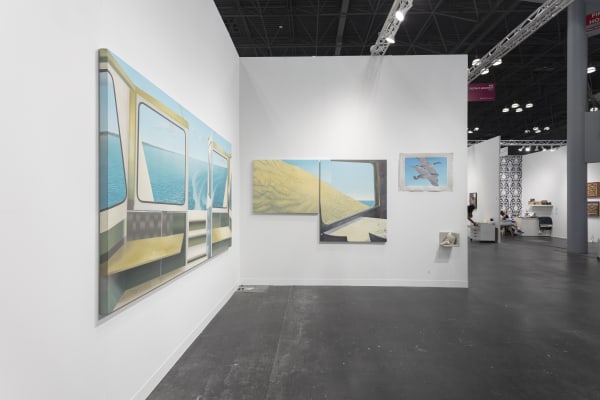Meghdad Lorpour: The Armory Show 2021
A solo presentation of recent works by Meghdad Lorpour at booth P33, The Armory Show 2021.
-
 Installation View of Dastan's Booth,The Armory Show 2021.
Installation View of Dastan's Booth,The Armory Show 2021. -
 Installation View of Dastan's Booth,The Armory Show 2021.
Installation View of Dastan's Booth,The Armory Show 2021. -
 Installation View of Dastan's Booth,The Armory Show 2021.
Installation View of Dastan's Booth,The Armory Show 2021. -
 Installation View of Dastan's Booth,The Armory Show 2021.
Installation View of Dastan's Booth,The Armory Show 2021. -
 Installation View of Dastan's Booth,The Armory Show 2021.
Installation View of Dastan's Booth,The Armory Show 2021. -
 Installation View of Dastan's Booth,The Armory Show 2021.
Installation View of Dastan's Booth,The Armory Show 2021. -
 Installation View of Dastan's Booth,The Armory Show 2021.
Installation View of Dastan's Booth,The Armory Show 2021. -
 Installation View of Dastan's Booth,The Armory Show 2021.
Installation View of Dastan's Booth,The Armory Show 2021.
“Dislocate and Displace”
Dastan presents recent works by Meghdad Lorpour titled “Dislocate and Displace” at The Armory Show 2021.
Meghdad Lorpour (b. 1983, Shiraz) is an Iranian artist based in Tehran, Iran. He is a graduate of Painting from Shahed University, Tehran. Meghdad’s work has been exhibited in Iran since 1999 and he has been represented by Dastan since 2017, where his work has been presented at two solo exhibitions as well as several international art fairs including a solo booth at Artissima 2019, and presentations at Sydney Contemporary 2017 and Art Dubai 2018.
The works on display follow and build up upon two of the artist’s previous series, “Daryábár” and “Tangab”. Since 2014, the artist has been studying Iranian bodies of water and the role of water in shaping geography, landscape, mythology, culture and life in central and southern Iran. Most of the works he has produced since beginning these studies take influence from the natural landscapes of Fars Province, an ancient cradle of human civilization as well as a vast region of natural wonders.
In addition to the role of nature in shaping the geography and landscape of Fars, thousands of years of human life and intervention have left considerable marks on the region. During his work on “Daryábár” and “Tangab”, Meghdad Lorpour, who is currently based in Tehran some seven hundred kilometers north of his hometown of Shiraz in Fars Province, would often supplement his desk research with travel, observation, documentation and a contemplative approach to painting.
In the course of his research, the artist would engage in comparative analyses of historical data, older accounts, sketches and photographs, personal memories of the locations in the past, and present-day observations. This approach would often lean towards corroborating the substantial changes in the natural landscapes as well as the difficult truth about the fast-paced dire effects of climate change in the region. While drought and climate warming have been and remain global issues, their severity has been felt especially intensely in the Middle Eastern countries. These hard facts along with the many human factors, notably mismanagement of the already-scarce resources and administrative failure as well as regional disputes, are parameters that have continuously contributed to environmental degradation, wars over water, mass immigrations, and much more Prior to the global COVID-19 pandemic, the artist would frequently visit the sites in Fars Province and the southern regions of Iran, including Tangab area, the now-dried Lake Parishan, Lake Bakhtegan, Lake Maharloo, Hamun Oasis, as well as Goor Plain and Hengam Island, all of which were home to ancient human settlements, possessing an aura of mythological history to them. Gathering images and inspirations, he would then start work on his compositions, taking ideas from both historical accounts, i.e., the experience of others, and his own observations and research.
Absence is a key theme in Meghdad Lorpour’s compositions and perspectives —on one hand, many of the sights he paints either no longer exist as they have been depicted in the pieces, and on the other hand, the artist controls the viewer’s range of vision and field of view by limiting perspective, depth, frame, and visual cues. In his three-dimensional papier-mâché pieces, the same effect is intensified by introducing a sense of ambiguity —while appearing as eerily familiar objects, one cannot pinpoint what these actually are and purpose they serve. They appear like ancient objects that have continued to live on through history; gradually reshaped and morphed by the passage of time, the introduction and propagation of culture, the greedy gaze of humanity, and gently-erosive marks of the cycle of life.
During his work on “Dislocate and Displace”, the artist could no longer travel to the locations he was researching because of the pandemic and the restrictions put in place to prevent the spread of the novel coronavirus. As so, there was less potential for sensory experience of the locations and direct observation. Initially, the sense of not being able to travel had an almost crippling effect on the artist’s work, but Meghdad soon began to contemplate on how human beings have always felt a need for movement and mobility. This new perspective led to a rethinking of the sense of absence that had been a core concept in many of his previous pieces. In “Dislocate and Displace”, the absence has been appropriated as ambiguous dualities that are simultaneously present in the paintings: stillness versus movement, far versus close, wider field of views versus looking through small limited windows and openings.
Similar to when one who has embarked on a journey long ago suddenly finds themselves far away from home, the landscapes, surroundings, and objects feel either too generic or completely unfamiliar, and upon confusion, the traveler’s faculty of recall returns with no answers, general recollections or distinct memories. The artist looks around, casts his gaze on a few uncanny configurations in the setting, studies the mountains and waters in his peripheral vision or the distant backgrounds, and continues his imaginary immigration, determined yet constantly unsure.










